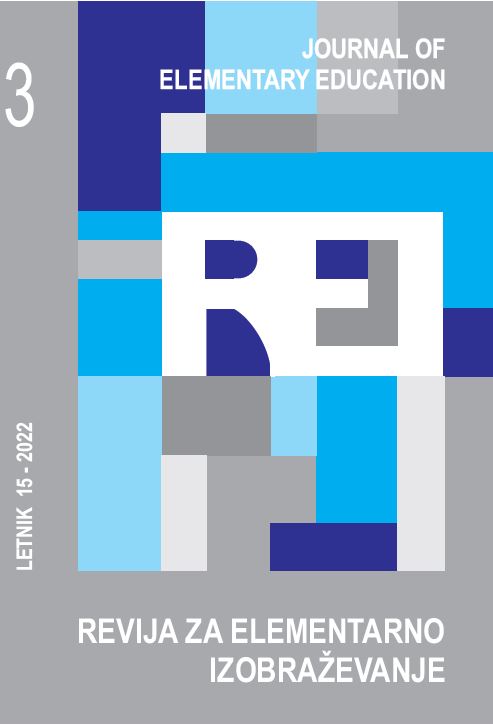Integration of Bilateral Coordination in Children’s Motor Learning Process
DOI:
https://doi.org/10.18690/rei.15.3.285-299.2022Keywords:
high jump, scissors technique, bilateral exercising, unilateral exercising, dominant legAbstract
The purpose of this research was to establish the differences in the bilateral and unilateral exercising effects on high jump performance using the scissors technique, with take-off from the dominant leg. As many as 74 participants aged 7 to 12, who were randomly chosen and divided into two experimental groups, took part in the study. The experimental groups had training twice a week for twelve weeks. Measurements were conducted at three points in time, and the results showed that the bilateral training intervention produced symmetrical effects equal to those from unilateral interventions of exclusively the dominant leg, which finding is extremely important for symmetrical muscular and locomotor development, as well as for a practical approach to children.
Downloads
References
Berk, R. A., and DeGangi, G. A. (1983). DeGangi-Berk Test of Sensory Integration Manual. Los Angeles, CA: Western Psychological Services.
Blažević, I., Antekolović, L., and Mejovšek, M. (2006). Variability of high jump kinematic parameters in longitudinal follow-up. Kinesiology Journal, 38(1), 63–71.
Castanharo, R., Veras, M. I. O., Alcantra, C., Miana, A., Manoel, E. J., Proenca, J. E., and Duarte, M. (2011). Asymmetries between lower limbs during jumping in female elite athletes from the Brazilian national volleyball team. Portuguese Journal of Sport Sciences, 11(2), 53–56.
Coynel, D., Marrelec, G., Perlbarg, V., Pélégrini-Issac, M., Van de Moortele, P. F., Ugurbil, K., Doyon, J., Benali, H., and Lehéricy, S. (2010). Dynamics of motor-related functional integration during motor sequence learning. Neuroimage, 49(1), 759–766.
Cuckova, T., and Suss, V. (2014). Muscle Imbalance and Body Composition of Elite Junior Female Volleyball Players. Paripex-Indian Journal of Research, 3(4), 1–2.
Čoh, M. and Supej, M. (2008). Biomechanical model of the take-off action in the high jump– A case study. New Studies in Athletics, 23(4), 63–73.
Dapena, J. (1988). Biomechanical analysis of the Fosbury-Flop, part I. Track Technique, 104, 3307–3317; 3333.
Dapena, J., and Flickin T. K. (2006). Scientific services project – high jump. Biomechanics Laboratory, Department of Kinesiology, Indiana University. Available at: https://sportbm.sitehost.iu.e-du/High-Jump-Report-32-2007-Men-lodef.pdf (Accessed: 8. 5. 2021)
Fazlioglu, Y., and Gunsen, O. M. (2011). Sensory motor development in autism. In Mohammed-Reza Mohammadi (ed.), A Comprehensive Book on Autism Spectrum Disorders, (pp. 345–68). Rijeka, Croatia: InTech.
Focke, A., Spancken, S., Stockinger, C., Thürer, B., and Stein, T. (2016). Bilateral practice improves dominant leg performance in long jump. European Journal of Sport Science, 16(7), 787–793.
Grouis, G., Kiodou, I., Tsorbatzoudis, H., and Alexandris, K. (2002). Handedness in sport. Journal of Human Movement Studies, 43(4), 347–361
Gruić, I. (2014). Odnosi sadržajnog, formalnog i funkcionalnog procjenjivanja izvedbi elemenata tehnike u kompleksnim kineziološkim aktivnostima na primjeru sportske igre: rukomet. Zbornik radova 23. Ljetne škole kineziologa, 526–532.
Haaland, E., and Hoff, J. (2003). Non-dominant leg training improves the bilateral motor performance of soccer players. Scandinavian Journal of Medicine and Science in Sports, 13(3), 179–184.
Horga, S. (1993). Psihologija sporta. Fakultet za fizičku kulturu, Zagreb.
Jacoby, E. and Fraley, B. (1995). Complete Book of Jumps. Champaign, IL: Human Kinetics.
Kovács, I., Tihanyi, J., Devita, P., Rácz, L., Barrier, J., and Hortobágyi, T. (1999). Foot placement modifies kinematics and kinetics during drop jumping. Medicine and Science in Sports and Exercise, 31(5): 708–16.
Kraemer, WJ, and Newton, RU. (1994). Training for improved vertical jump. Sports Science Exchange, 7(6), 1–12.
Marinsek, M. (2016). Lateral asymmetry as a function of motor practice type of complex upper- and lower-limb movement in young children. Laterality: Asymmetries of Body, Brain and Cognition, 21(3), 267–281.
Petrić, V., Kostadin, L., and Peić, M. (2018). Evaluation of an integrated programme of physical exercise with nursery-aged children: impact on motor achievements. Journal of Elementary Education, 11(3), 189–200.
Pittenger, V. M., McCaw, T. and Thomas, D.Q. (2002). Vertical ground reaction forces of children during one- and two-leg rope jumping. Research Quarterly for Exercise and Sport, 73(4), 445-449.
Saratlija, P. (2020). Kinematička i kinetička obilježja specifičnih vježbi odraza skakačica u vis. Doktorski rad. Kineziološki fakultet Sveučilišta u Zagrebu.
Sinclair, J., Fewtrell, D., Taylor, P. J., Atkins, S., Bottoms, L., and Hobbs, S. J. (2014). Three-dimensional kinematic differences between the preferred and non-preferred limbs during maximal instep soccer kicking. Journal of Sports Science, 32(20), 1914–1923.
Teixeire, L.A., Silva, M.V.M, and Carvalho, M.A. (2003). Reduction of lateral asymmetries in dribbling: The role of bilateral practice. Laterality, 8(1), 53–65.
Vujičić, L., Peić, M., and Petrić, V. (2020). Representation of Movement-Based Integrated Learning in Different Physical Environments of an Early Education Institution. Journal of Elementary Education, 13(4), 453–474.
Williams, H. G. (1983). Perceptual and Motor Development. Englewood Cliffs, NJ: Prentice-Hall
Downloads
Published
Issue
Section
License
Copyright (c) 2022 Sanja Ljubičić, Ljubomir Antekolović, Vilko Petrić

This work is licensed under a Creative Commons Attribution 4.0 International License.
